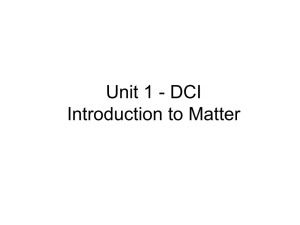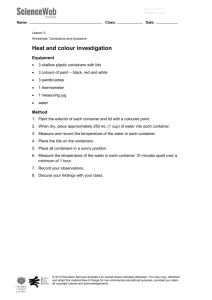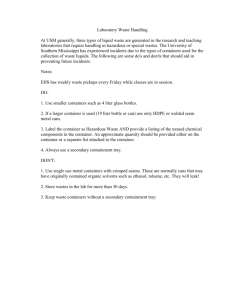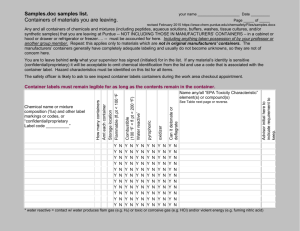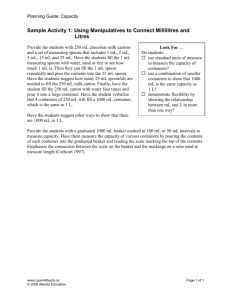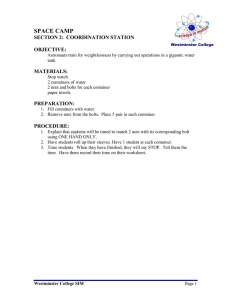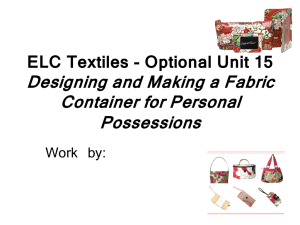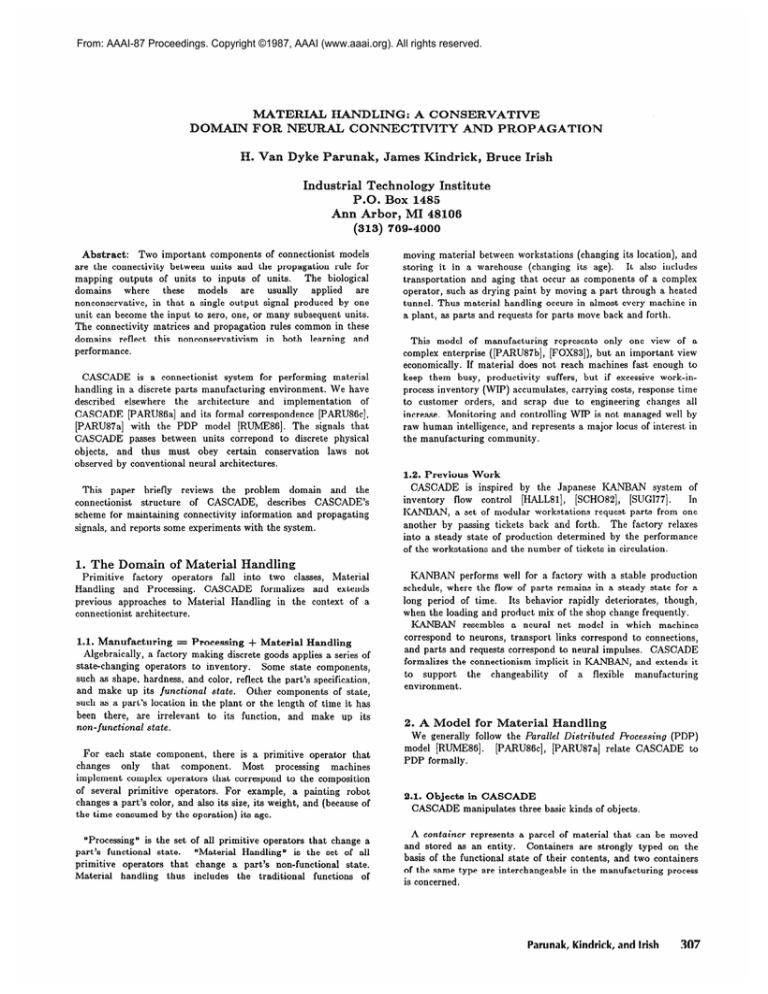
From: AAAI-87 Proceedings. Copyright ©1987, AAAI (www.aaai.org). All rights reserved.
MATERIAL
I-IANDEING: A CONSERVATIVE
N FOR NEURAL CONNECTIVITY
AND PROIFPAGATION
H. Van Dyke I?arunalc, James Kindrick,
Bruce Irish
Industrial Technology Institute
P.O. Box 1485
Ann Arbor, MI 48106
(313)
Abstract:
Two important components of connectionist models
are the connectivity
between units and the propagation
rule for
The biological
mapping outputs of units to inputs of units.
applied
are
domains
where
these
models
are
usually
nonconservative,
in that a single output signal produced by one
unit can become the input to zero, one, or many subsequent units.
The connectivity
matrices and propagation rules common in these
domains
reflect this nonconservativism
in both learning and
performance.
CASCADE
is a connectionist
system for performing
material
handling in a discrete parts manufacturing environment. We have
described
elsewhere
the architecture
and implementation
of
[PARU86c],
CASCADE
[PARU86 a] and its formal correspondence
[PARU87a]
with the PDP model [RUME86]. The signals that
CASCADE
passes between units correpond to discrete physical
and thus must obey certain conservation
laws not
objects,
observed by conventional neural architectures.
This
paper
briefly
reviews
the
problem
domain
and
the
structure
of CASCADE,
describes
CASCADE’s
connectionist
scheme for maintaining connectivity
information and propagating
signals, and reports some experiments with the system.
11. The Domain of Material
Handling
Primitive
factory
operators
fall into two classes, Material
Handling
and Processing.
CASCADE
formalizes
and extends
previous approaches
to Material Handling in the context of a
connectionist architecture.
1.1. Manufacturing
= Processing + Material Handling
Algebraically,
a factory making discrete goods applies a series of
state-changing
operators to inventory.
Some state components,
such as shape, hardness, and color, reflect the part’s specification,
and make up its junctional
state.
Other components of state,
such as a part’s location in the plant or the length of time it has
been there, are irrelevant
to its function,
and make up its
non- junctional
state.
For each state component,
there is a primitive operator that
changes
only
that
component.
Most
processing
machines
implement complex operators that correspond to the composition
of several primitive
operators.
For example, a painting robot
changes a part’s color, and also its size, its weight, and (because of
the time consumed by the operation) its age.
“Processing”
is the set of all primitive operators that change a
part’s functional
state.
“Material
Handling” is the set of all
primitive
operators
that change a part’s non-functional
state.
Material
handling
thus includes
the traditional
functions
of
769-4800
moving material between workstations (changing its location), and
It also includes
storing it in a warehouse (changing its age).
transportation
and aging that occur as components of a complex
operator, such as drying paint by moving a part through a heated
tunnel. Thus material handling occurs in almost every machine in
a plant, as parts and requests for parts move back and forth.
This model of manufacturing
represents only one view of a
complex enterprise ([PARU87b],
[FOX83]), but an important view
economically.
If material does not reach machines fast enough to
keep them busy, productivity
suffers, but if excessive work-inprocess inventory (WIP) accumulates, carrying costs, response time
to customer orders, and scrap due to engineering changes all
increase. Monitoring and controlling WIP is not managed well by
raw human intelligence, and represents a major locus of interest in
the manufacturing community.
1.2. Previous Work
CASCADE
is inspired by the Japanese KANBAN
system of
inventory
flow
control
[HALL81],
[SCH082],
[SUGI77].
In
KANBAN,
a set of modular workstations request parts from one
another by passing tickets back and forth.
The factory relaxes
into a steady state of production determined by the performance
of the workstations and the number of tickets in circulation.
WAN
schedule,
performs well for a factory with a stable production
where the flow of parts remains in a steady state for a
Its behavior rapidly deteriorates, though,
long period of time.
when the loading and product mix of the shop change frequently.
KANBAN
resembles a neural net model in which machines
correspond to neurons, transport links correspond to connections,
and parts and requests correspond to neural impulses.
CASCADE
formalizes the connectionism implicit in WAN,
and extends it
to support
the changeability
of
a flexible
manufacturing
environment.
2. A Model for Material
Handling
We generally follow the Parallel Distributed
F’rocessing (PDP)
model [RUME86].
[PARU86c],
[PARU87a] relate CASCADE
to
PDP formally.
2.1. Objects in CASCADE
CASCADE manipulates three basic kinds of objects.
A container
represents a parcel of material that can be moved
and stored as an entity.
Containers are strongly typed on the
basis of the functional state of their contents, and two containers
of the same type are interchangeable in the manufacturing process
is concerned.
Parunak,
Kindrick,
and Irish
307
A unit is a collection of containers that are geographically
and
functionally related.
There are two types of units, corresponding
to two types of relations between containers.
1. If all the containers in a unit have the same type, the
No functional processing can take
unit is a TOMP.
place in such a unit, otherwise incoming containers
would differ in type from outgoing ones.
2. If the containers in a unit are participants in the same
functional operation, the unit is a process.
A process
consumes
containers
of zero or more types
and
produces containers of zero or more types.
It differs
from a TOMP in two ways. Its behavior is stochastic
rather than deterministic (at least from the perspective
of the material handling system), and its output can be
of a different type than its input.
This section
that are in the same
types
of
aggregates,
1. A mover is a collection of TOMP’s, and models a single
geographically
limited material handling module, such
as a conveyor loop, a zone of an AGV (automatic
guided vehicle) system, or an ASRS (automatic storage
2. A workstation
is a collection of processes that run on a
single geographically
local and functionally
integrated
set of machines
(typically,
a machine
tool with
associated transfer and inspection mechanisms).
Every unit belongs to exactly one aggregate,
association unless the system is reconfigured.
Among Units
has a maximum
and
and
a minimum
retains
capacity
this
for
containers of its type, and is connected to one or more other units
If its population
(the number
of
on adjacent
aggregates.
containers it contains) exceeds its maximum capacity, it seeks to
spill the excess to a neighboring unit. If its population falls below
its minimum capacity, it seeks to fill up to the minimum from its
Thus the units form a network
through
which
neighbors.
containers and requests for containers propagate.
This behavior
results in a mechanism
that is a superset of
KANBAN.
We can set capacities to make TOMP’s
behave like
links in a traditional
KANBAN
system [PARU86a].
However,
because we can push as well as pull material through a CASCADE
net, we can distribute material ahead of time to anticipate changes
in production requirements, and thus avoid. MAN’s
problems
when production is not steady-state.
The requests and acquisitions that result from fills and spills are
local messages, allowing one TOMP to propagate its constraints to
its nearest neighbors.
The TOMP’s
correspond to neurons in a
neural net, while requests and containers
correspond
to interneural impulses and capacities correspond to neural threshholds.
Experiments
with CXXADE
[PARU86c]
show that it does
control WIP levels and reduces waiting time for parts at machines.
308
Cognitive
Modeling
develops
the notion
in CASCADE
of conservation
in propagation
rules,
and
3.1. Conservation
in Propagation
Rules
In the PDP model, signals travel from unit to unit through
connections.
A propagation
rule determines whether the output
from one unit reaches the input of another.
In the simplest
propagation
rules, the vector that represents the inputs to each
unit is computed
as the product of the output vector and a
connectivity
matrix, and a single output can contribute to many
inputs, or to none. That is, neural propagation does not conserve
impulses. It can effectively multiply a single impulse by routing it
to many inputs, or destroy an impulse by not passing it anywhere.
A system can differ from this standard
and retrieval system).
2.2. Messages
Each TOMP
and Propagation
One motive
for developing
the parallel
between
material
handling and connectionist
models is the adaptive nature of such
These models learn by modifying
the weights in their
models.
connectivity
matrices.
Weights can be modified locally, on the
basis of the experience of an individual unit, without invoking a
that knows the state of the entire
global
“learning
module”
Such a local learning scheme offers great promise in
system.
coping with the complexity of a large material handling network
in a flexible
manufacturing
environment,
where part types,
quantities, and distribution are continually changing.
rules, describes CASCADE’s
implementation
of such
reports some simple experiments with the system.
Every container belongs to exactly one unit at a time, and moves
from unit to unit as the system operates.
An aggregate
is a collection
of units
geographical
area.
There
are two
corresponding to the two types of units.
3. Connectivity
model in two ways.
1. It might require quantitative
conservation of signals, so
that the total output at one time step equals the total
This constraint can be
strength input at the next.
implemented
by normalizing
each column
in the
connectivity
matrix so that total output equals total
input.
conservation,
in *which
2. It might require qualitative
signals are discrete packets that must be propagated
intact.
This constraint
can be implemented
by
interpreting
the weights,
not as shares into which
signals are divided,
but as the probability
that a
packet from one unit arrives at another.
CASCADE
exhibits
both
quantitative
and
qualitative
conservation.
If a container leaves one unit, the same container
Thus the weights in each
must arrive at precisely one unit.
column of the connectivity
matrix for containers in CASCADE
sum to one, and each is interpreted as the probability
that a
container from the source will go to the target.
Requests are not subject to the same physical constraints that
containers are. In our system, though, each request results in the
delivery of a container.
If propagation
multiplies requests, the
system as a whole will send many more containers than needed
toward the node that initiated the request, and the rest of the
network will starve for that type of container.
Thus, we require
propagation to conserve requests as well as containers.
3.2. Implementing
Connectivity
and Propagation
One can model connectivity
in CASCADE
as weight matrices
Containers and
interpreted probabilistically,
as outlined above.
requests have distinct matrices, reflecting different connectivities.
In our implementation,
each unit stores its column of each of the
matrices,
t for container
connectivity
and 7 for request
connectivity.
ci is the probability
that the next container spilled
from this unit will be sent to unit i, and ri is the probability
that
the next request for a container will be sent to unit i. The total
number of units is n, and the probability interpretation requires
n-l
n-l
weight for the requesting
i=O
should be decremented
Entries in Z and t can be nonzero only if physical connections exist
between the associated aggregates, and in most installations these
connections do not vary dynamically,
so in practice these vectors
are sparse and only their nonzero elements need be manipulated.
These vectors are the locus both of propagation
monitoring changes in the environment.
decisions
3.2.1. Propagation
Decisions
When a unit is ready to spill or fill, it generates a random
number 0 < r 5 1, and uses it to select an element from the
appropriate vector.
This element then becomes the target of the
request or container being output.
For instance, a spilling unit
sends its excess container to cj such that
j-l
C
i=O
ci<r5
neighbor
(say, by R).
2. When one unit spills a container
to another, the
receiving neighbor is less likely to need one than it was
So its weight in the sending unit
before the spill.
&.=pi=l
i=O
1. When a neighbor requests a container, we know that it
has some interest in receiving containers.
So when a
unit receives a request, it augments the container
ilci
i=O
3.2.2. Modifying the Vectors
Some principles for managing
the connectivity vectors in a unit
are the same for both container and request connectivities,
and
apply in general to any connectionist architecture that requir *es a
conservative propagation rule.
o Bayesians will set the initial values in the connectivity
vectors for a unit on the basis of their a prioris.
Others will probably
set them to l/n,
dividing the
probability equally among them.
e As the system learns, certain weights change, and the
remaining values in the vector must be adjusted in the
opposite
direction
to keep the total at 1.
One
computationally
simple strategy is to adjust the desired
entry by a, then divide every element in the vector by
1 +a.
* As individual
weights approach
zero, the associated
units are for all practical purposes disconnected from
the sending unit.
Once “forgotten”
in this way, they
will never be selected.
It is easy to show that if the
desired
containers
exist in the system,
allowing
connection weights to attain zero value insures that
requests will be satisfied
in bounded
time.
In
applications
where
this
irrevocable
forgetting
is
undesirable,
we set maximum
and minimum
limits
beyond which a unit’s weight is not adjusted.
The
actual
adjustments
made
to individual
weights
are
determined differently for containers and requests.
The protocols
outlined here reflect the semantics of our application, and may be
different for a different application.
The container vector I for a unit records the probability
of
selecting each of that unit’s neighbors as the recipient of a spilled
container.
The weights reflect our judgment that a given neighbor
desires containers.
Two events affect this judgment.
(say, by S).
The sizes of adjustments for receiving a request or delivering a
spill are tuning parameters.
Their ratio R/S reflects the impact of
a single request. If this ratio is greater than one, the spilling unit
interprets a single request as expressing a relatively long-term
If it is less than one, the spilling
interest in receiving containers.
unit attaches
much less significance
of a single request.
The average
to the long-term
implications
value of R and S reflects
quickly the spilling unit shifts its attention
how
to a requesting unit.
The request vector i for a unit records the probability
of
selecting each of that unit’s neighbors as the recipient of a request
issued by the unit. The weights reflect our judgment that a given
neighbor has a container in stock, or has access to a container
from one of its neighbors.
We modify these weights on the basis
of the neighbors’ cost of effort (COE) in filling past requests.
In
the present implementation,
the COE is the number of units that
Each time a neighbor
were searched to find a container.
successfully
satisfies a request, we augment its weight (in the
where U is a constant).
Each
current implementation,
by UjCOE,
time a neighbor fails to satisfy a request, we decrement its weight
Again, the average
(in our implementation,
by a constant v).
value of U and V determines the stability and rate of learning of
the system, while their ratio controls whether success or failure has
more impact on the learned behavior.
This back-propagation
error-correction
algorithm is similar
that used in the perceptron convergence theorem [ROSEfX].
differs from the classical procedure in two main ways.
to
It
1. Traditional
systems
distinguish
the learning
and
performance phases. In the learning phase, the system
converges to a stable set of connection weights that
produce a desired output pattern by modifying those
weights
using
back-propagation.
During
the
performance
phase, weights are not modified and the
network is no longer adaptive.
Our problem domain
requires continual adaptive behavior, merging the two
phases
by
modifying
connection
weights
during
performance.
This strategy
is necessary since the
desired output pattern is not fixed, but continually
varies as containers move through the system.
2 The classical approach
modifies connection
weights
proportional
to the magnitude of error, the difference
between output produced and desired output.
In our
system the desired output pattern is variable, so the
traditional
notion of error is not well defined.
The
same activation level may be an error during one trial
and correct during another.
Therefore we apply a
constant negative reinforcement on error. Our system
propagates back the cost of achieving a success rather
than the degree of failure.
The magnitude
of
connection weight adjustment
is proportional
to this
COE of success.
The depth to which search proceeds before reporting failure, and
the number of trials that a unit makes before reporting failure, are
Parunak,
Kindrick,
and Irish
309
parameters
of the model.
the
proceeds
search
neighbor
In the implementation
depth-first,
before reporting
and
each
unit
described
tries
only
here,
one
success or failure.
3.3. Experimental
Results
Figure 1 shows the connectivity
of some of the units (TOMP’s
and processes) in ITI’s Advanced Manufacturing Center, a working
CIM cell in which CASCADE
is implemented.
These particular
units manipulate empty boxes into which processes pO7 and ~08
pack finished parts.
To demonstrate the system, we load TOMF’
t26 (an ASRS) with 15 empty boxes, and begin retrieving from pO7
and ~08. When the 15 boxes from t26 are gone, we load 15 more
at ~04 (a process that loads inventory at a manual workstation).
For each retrieval we record the cost of effort, (COE), the number
of units that, CASCADE searched to find the requested part. The
minimum COE possible is 6 from t26 and 5 from ~04.
Figure 3 shows COE as a function of retrieval when the weights
For this
are allowed to vary in response to success and failure.
trial, we augment the weight of a successful neighbor by O.l/COE,
and decremented the weight of an unsuccessful one by 0.01. The
COE drops as the system learns to go to t26 for boxes. Limited
exploration of other units continues at trials 11, 13, and 14, even
after focusing on t26.
The COE rises when the boxes run out at
t26, then drops as the system discovers the new source at ~04.
Over the entire run, the median COE is 11, the inter-quartile
spread is 13, and the standard deviation is 16.
Figure
1: “Empty
Retrievals
With
Learning
IBB
C
t
Figure
3:
98
78
Box” Units
0
PO7
Retrieval
As a control run, we assign probability l/n to each connection in
each TOMP,
and do not, vary these weights
as the system
operates.
Thus later retrievals do not learn from the success or
failure of earlier ones. Figure 2 shows the COE as a function of
retrieval. The variability results solely from the stochastic search
process.
The median COE to retrieve a box is 22.5, the interquartile spread is 38.5, and the standard deviation is 28.9.
Figure
100
C
2:
Retrievals
Without
Figures 4 and 5 show how the probability
assigned to each
neighbor of TOMP’s tl2 and tO5, respectively, changes during the
30 retrievals described in Figure 3. These TOMP’s are the major
decision points in the system, and the weights of the connections
between them and their neighbors are the main locus of learning in
this experiment,. For each retrieval, the vertical space between the
x axis and the line at y = 1.00 represents unit probability,
and is
divided into as many bands as the TOMP under consideration has
neighbors.
The relative width of each band shows the weight of
the connection to the associated neighbor.
Figure
I-I:
Connection
Weights
irom
TOMP
t12
Learning
-y-
98
--
BB
--
t
78
--
0
60
--
58
--
Retrieval
E
f
f
“0
--
30
--
0
i@
--
18
--
For instance, Figure 4 shows three horizontal bands, one each for
t54, tO5, and t61. In our experiment, requests all enter from t54,
so it never succeeds or fails, and its probability remains constant.
of
the
connection
to
t05
increases
through
The
weight
normalization
when t61 fails, and increases through augmentation
when it succeeds, so it increases monotonically.
Similarly, the
weight of the connection to t61 falls monotonically.
Since t05 is
on the route to both sources of empty boxes, it grows both before
and after the switch from t26 to ~04.
0
S
f
r
t
310
T
\/;,
Cognitive
Modeling
t05
Figure
’ o0 rP
r
lz
B RB -
5:
---
Connec
t Lj 0
--
4
t 12
0 “8 -
t33
Weights
from
TOMP
References
tB5
“Constraint-Directed
Search: A Case
[FOX831 Fox, M., 1983.
Study of Job-Shop Scheduling.”
Carnegie-Mellon University:
///--------
4’7
B se -
tion
Robotics
Institute
CMU-RI-TR-83-22;
Department CMU-CS-83-161.
-.---I
i
t
0 2BCJ
“:!:‘-:--;---::t 19
[HALL811 Hall, R.W., 1981. Driving
the Productivity
Machine.
American Production and Inventory Control Society.
Retrieval
----Figure
5 tells a similar
story.
-
Now the weight
of
tlz
remains
constant, since it does not participate in the competition.
As long
as t26 has boxes, t19 (which leads to it) gains weight.
When we
switch to ~04, tl9 rapidly loses weight and t40 (now on the correct
route) becomes prominent.
4. Summary
CASCADE
uses
a connectionist
model
to
manage
the
distribution
and
movement
of
inventory
in
a
discrete
It differs from traditional
neural
manufacturing
environment.
models in conserving its signals as they propagate between units.
We have described a scheme that adjusts the connectivity of such
a network dynamically
and propagates signals with the required
conservation.
Ongoing
Science
[FOX851 Fox, B.R.;
and K.G. Kempf,
1985.
“Complexity,
Uncertainty, and Opportunistic
Scheduling.”
Second IEEE
Conference
on Artificial
Intelligence Applications,
Miami,
FL, 487-492.
E
i1
Computer
research is probing
several directions.
e This system modifies weights as it uses them, and so
Because of the
merges learning and performance.
the
application,
characteristics
of
conservation
propagation
of requests and containers
is strongly
serial, and a failed request is an expensive way to
Under
some
circumstances,
it may
be
learn.
advantageous
to add a separate parallel search of the
In the
network to set weights from time to time.
multiprocessor
environments
for which CASCADE
is
intended,
such a phase reduces the cost of futile
requests.
favors
environment
flexible
manufacturing
@A
integration of learning and performance
for material
handling
because
the distribution
of supply
and
demand for inventory varies continuously.
Probably,
though, certain distribution
states recur periodically,
due to repeated runs of the same parts and customer
order cycles. We can store the weights periodically as
a function of an estimator of system state, and then
retrieve them to shorten the adaptation time.
can learn by modifying
e Units in CASCADE
threshholds as well as their connectivity.
Some of the original ideas in CASCADE
originated
their
in discussions
with Bob Judd.
The work described in this report was financed
by a grant from the Kellogg Foundation.
[PARU85a] Parunak, H.V.D.; B.W. Irish; J. Kindrick; and P.W.
Lozo, 1985.
“Fractal Actors for Distributed Manufacturing
Control.”
Proceedings
o j the Second IEEE Conference
on
AI Applications.
[PARU86a] Parunak, H.V.D.; P.W. Lozo; R. Judd; B.W. Irish;
J. Kindrick,
1986.
“A Distributed Heuristic Strategy for
Proceedings
of
the
1986
Material
Transportation.”
Conference
on Intelligent
Systems
and Machines,
Oakland
University, Rochester, MI.
[PARU86b] Parunak, H.V.D.; J.F. White; P.W. Lozo; R. Judd;
B.W.
Irish; J. Kindrick,
1986.
“An Architecture
for
Heuristic
Factory
Control. ‘I
Proceedings
of the
1986
American
Control Conference.
[PARU86c]
Parunak,
H.V.D.,
and
James
Kindrick,
“A
Connectionist
Model for Material Handling.” Presented at
the Seventh DAI Workshop, Gloucester, MA, Oct. 1986.
[PARU87a] Parunak, H.V.D., James Kindrick, and Bruce W. Irish,
“A
Manufacturing
Application
of
a Neural
Model.”
Submitted to IJCAI-87.
[PARU87b] Parunak, H.V.D., and John F. White,
for Comparing
CIM Reference
Models.”
Meeting,
International
Purdue
Workshop
Computer Systems, April, 1987.
[REES86] Rees,
Adjusting
Production
“A Framework
Spring
1987
on Industrial
L.P.; and P.R. Philipoom,
1986. “Dynamically
the Number
of Kanbans
in a Just-In-Time
System.” 1986 S.E. AIDS (prepublication
draft).
[ROSE621 Rosenblatt,
F.,
New York: Spartan.
1962.
Principles
of
Neurodynamics.
[RUME86] Rumelhart,
D.E.; G.E. Hinton; and J.L. McClelland,
1986.
“A General
Framework
for Parallel
Distributed
Processing.”
In Rumelhart and McClelland,
eds., Parallel
Distributed
Recessing,
Cambridge: MIT Press, 1.45-76.
[SCHO82]
R. J.
Techniques.
Schonberger,
1982. Japanese
New York: The Free Press.
Manu jacturing
[SUGI77] Sugimori, Y.; K. Kusunoki; F. Cho; and S. Uchikawa,
1977. “Toyota
production
system and Kanban
system:
Materialization
of
just-in-time
and
respect-for-human
system.”
International
Journal
o j Boduction
Research
IS:& 553-564.
Parunak,
Kindrick,
and Irish
311

